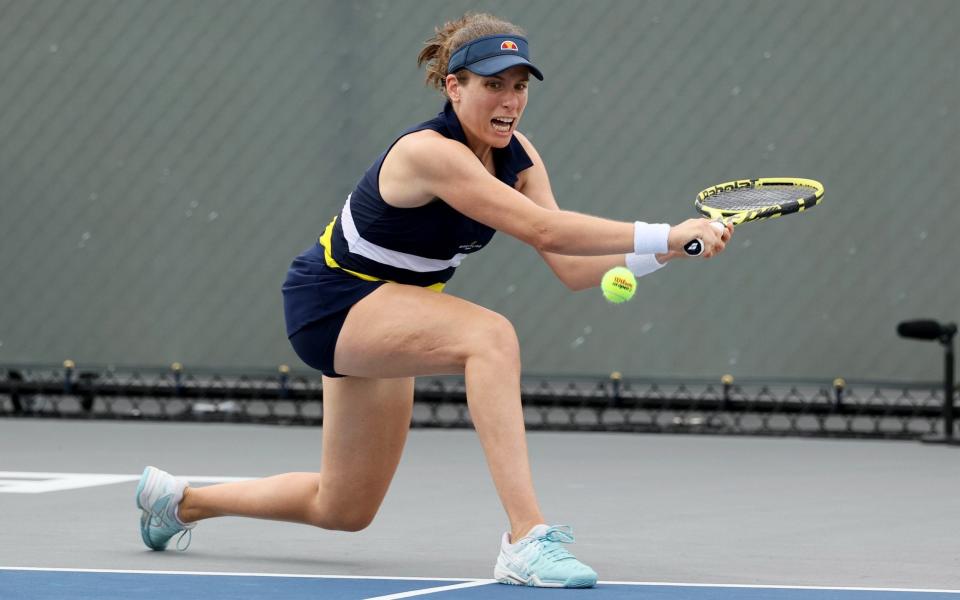Johanna Konta suffers heart palpitation on competitive return at Kentucky tournament

British No1 Johanna Konta suffered an alarming palpitation during her first post-lockdown tennis match on Monday night, prompting a debate over what might have caused the sudden spike in her heart-rate.
Speaking on Amazon Prime, the former US Open finalist Greg Rusedski suggested that Konta’s issues stemmed from her anxious mindset: the result of “putting too much pressure on herself”. But two cardiologists told Telegraph Sport that she may be suffering from a minor congenital abnormality.
“Basically my heart-rate shoots up for no reason,” Konta told reporters after her 6-4, 6-4 defeat by Marie Bouzkova on Monday night. “We are keeping an eye on it, having all the heart checks. It’s one of those things you need to catch in the moment and be able to record it and measure. Which we haven’t been able to do, as it has been sporadic.”
Konta’s management confirmed that she had undergone more precautionary tests after the latest incident. But it is notoriously difficult to monitor cardiac malfunctions of this kind.
During her post-match interview, Konta explained that this was her fourth such episode since 2017 – three of which have come during matches and one on the training court. To identify the condition, you need to be tracking the electrical signals within the heart at the exact moment when it accelerates.
The most likely explanation is a condition called supraventricular tachycardia – or SVT for short. “Imagine the heart as a badly run orchestra,” said Professor Guido Pieles, a sports cardiologist with the Institute for Sport, Exercise and Health (ISEH). “If some violins get ahead of the conductor, and then everyone else starts following them, speeding up the beat, that’s SVT.
“A normal 30-year-old athlete would have a maximum heart-rate of 200, but with SVT that can suddenly climb to 260. It’s not often dangerous but it is inefficient, because the heart doesn’t have time to fill before it pumps, and it can affect performance.
“I am sure that everything is being handled professionally by Johanna’s team,” added Professor Pieles, “but there are various ways of trying to monitor the issue, maybe by wearing little stickers that pick up the heart signals or implanting a tiny device under the skin. You can even try to provoke an episode in the lab.
“If the symptoms are aggravating, I would investigate further. And if an arrhythmia is found, I would refer her to an electro-physiologist for an ablation [a minor procedure in which a small number of cells are strategically killed off, adjusting the circuitry of the heart].”
On Tuesday, Rusedski suggested that “There is a little bit of denial. When you’re stressed your heartbeat goes up, especially in hot conditions, and when you put too much pressure on yourself. So these things do happen to you and I think she has got to come out and admit to it.”
Rusedski’s comments were surely influenced by other previous occasions when Konta has been forced to leave the court during matches, notably the occasion at the 2016 US Open when she hyperventilated while playing Tsvetana Pironkova.
But as Konta explained on Monday night, that was caused by a different issue. “I was running out of oxygen. I have been able to sort that out and have protocols in place. I sometimes have to put the towel in front of my nose and breathe almost like a paper bag.”
Dr Lawrence Creswell, of the University of Mississippi, concurred with Professor Pieles. “It wouldn’t be wise to write this off as something simple,” he said.
As the tournament continued in Kentucky, Serena Williams faced Bernarda Pera in her first competitive match since February’s Fed Cup, and came from behind to claim a 4-6, 6-4, 6-1 victory.

